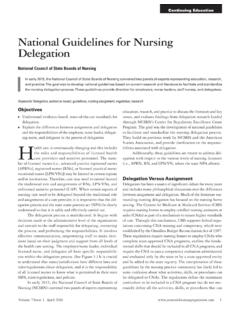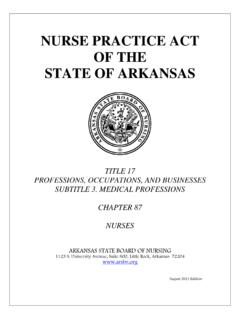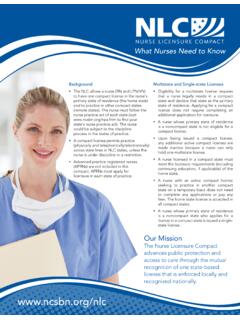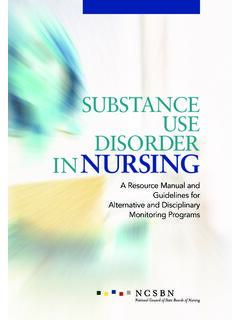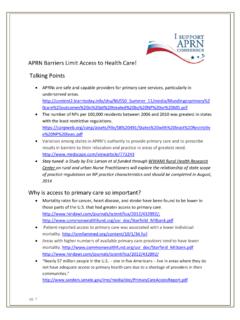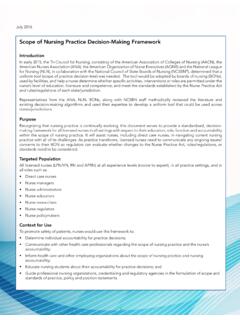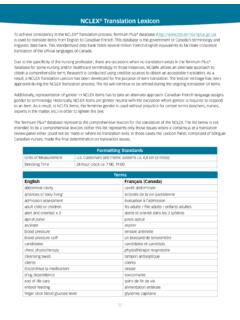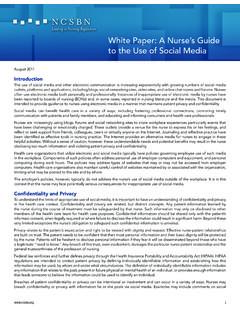Transcription of Critical Thinking in Nursing - NCSBN
1 Nursing Regulation & education Together Spring on page 2Q. We are implementing a new distance-learning program at our Nursing school and will hire qualified clinical faculty in a distant state to provide supervised clinical experiences. Where should the clinical faculty from a distance-learning program be licensed? A. This is a frequently asked question and the answer varies from state to state. You should contact your board of Nursing to learn of their rules about distance learning as there may be other rules you need to consider. In some states the board of Nursing must approve any clinical program that would enter their state, even if the distance-learning program has already been approved by the state of origin. In these states, for example, if the distance-learning program has been approved by one state, but students are being supervised in clinical practice by faculty in another state, the distance-learning program would have to be approved by both states.
2 Regarding licensure, many states require faculty members teaching in the virtual classroom to be licensed in the state where the program originates. They then require the faculty supervising students in the field to be licensed in the state where the student is in clinical practice. However, this varies from state to conducted a survey of the boards of Nursing in 2003 and the results of that survey provide some insight on the differences between the boards of Nursing regarding distance-learning programs. That survey can be accessed by visiting Critical Thinking in NursingLinda L. Kerby, MA, RN, C-R, Mastery education Consultations Kerby has published a Critical Thinking study guide for a medical surgical s the complexity of health care and the accountability of nurses increase, the need for Critical Thinking becomes more important in the classroom, in the boardroom and at the bedside. Evidence-Based Nursing practice, with its focus on empirical knowledge, relies on the features of Critical Thinking to provide an objective, goal-directed methodology for Delphi study of Critical Thinking in nursing2 identified skills integral to Critical Thinking in Nursing practice.
3 These include: analyzing, applying standards, discriminating, information seeking, logical reasoning, predicting and transforming knowledge. These skills are the hallmarks of scientific process; they are the core competencies of practitioners who use objective evidence to articulate and solve problems. By no means are these skills limited to advance practice nurses or those who do large-scale clinical research. They have become tools for everyday bedside Nursing as of the Mind for Critical ThinkingHabits of the mind3 that are essential for Critical Thinking portray the ideal nurse who is using objective, scientific problem-solving processes in a context of cultural and clinical variables. These include: 1) Confidence has the conviction to promote valid and practical judgments and opinions. 2) Contextual perspective takes into account the variables that affect the clinical situation such as ethnic influences, economic considerations and interpersonal dynamics.
4 3) Creativity uses imagination to devise original solutions to problems or ways to prevent them. 4) Flexibility is able to adapt ideas and resources to meet changing needs of various situations. 5) Inquisitiveness employs curiosity to formulate questions about how situations might be altered to improve patient care. 6) Intellectual integrity displays virtues such as honesty, impartiality and openness to the views of others. 7) Intuition examines insights and determines how information can be incorporated into solutions and innovations. 8) Open-mindedness does not form prejudices or reach conclusions prior to gathering and evaluating data. 9) Perseverance applies effort to working on problem solving and continues modifying and altering variables until a solution is achieved. 10) Reflection gives consideration to a situation, integrating diverse data and possible outcomes to devise and evaluate Thinking is best understood as the ability of thinkers to take charge of their own Thinking .
5 This requires that they develop sound criteria and standards for analyzing and assessing their own Thinking and routinely use those criteria and standards to improve its quality . Linda Elder and Richard Paul1 INSIDE ..Texas Encourages Innovation in Professional Nursing EducationA Big Problem .. Conference Addresses Faculty ShortageNCSBN Launches New NCLEX-PN Test Plan and Passing StandardNCSBN NCLEX Department Contact and more Critical Thinking in Nursing continued from front pageTexas Encourages Innovation in Professional Nursing EducationRobbin Wilson, MSN, RN, Nursing Consultant for education , Texas Board of NursingMary Beth Thomas, PhD, RN, Director of Nursing Practice/ education , Texas Board of Nursing2T he Texas Board of Nursing (BON) is making major strides in encouraging creativity and innovation in professional Nursing education delivered by pre-licensure Nursing educational programs throughout the state of Texas.
6 Studies from the Institute of Medicine indicate that educational programs for health care professionals must be responsive to the dynamic health care environment, an environment that is reacting to an increased use of technology, ongoing staffing shortages and an aging patient population. These and other competing factors in the health care environment demand the assurance that health care services are safe, effective and based on evidence of best Although regulation by the Texas BON calls for standardization and consistency in promoting quality , safe and competent Nursing care, the current health care environ-ment often necessitates change, innovation and flexibility by health care providers and climate that encourages and nurtures creativity and innovation in education is one that includes communication and collaboration with key education stakeholders. This climate is definitely present and viable in Texas.
7 In 2004, the Texas Nurses Association, in collabora-tion with these key stakeholders, including the Texas BON, convened a task force to outline strategies that would promote creative ap-plications for Nursing educational programs to meet the challenges presented by today s health care environment. The resulting initiative called for innovation as a framework for accomplishing this goal and provides specific recommendations from the task In support of these and other types of educational innovations, the Texas higher education Coordinating Board (THECB) created the Nursing Innovation Grant Program. Under this grant program, schools of professional Nursing were awarded grants for the purpose of developing new activities and projects that promote innovation in the education , recruitment and retention of both Nursing students and qualified Requests for flexibility and creativity from Nursing educational programs wanting to explore new approaches to Nursing education are received by the Texas BON on a consistent basis.
8 Consequently, in July 2005 the Texas BON began offering an application and proposal process to encourage the development, implementation and study of innovative applications for pilot programs as authorized by section of the Texas Occupations Code, enacted by Senate Bill 718 in the 78th Texas Legislature, Regular Session. It is anticipated that the research generated from these creative and innovative approaches that support the efforts of Nursing educational programs to graduate competent, safe nurses will result in improve-ment in the quality and delivery of Nursing education and subsequent replication of innovative strategies throughout the state of Texas BON, in collaboration with Nursing educators, the THECB and the Texas Health Care Policy Council, has recently responded to a legislative mandate to implement, monitor and evaluate a plan for the creation of innovative Nursing education models that promote increased enrollment in Texas Nursing To date, the board has undertaken several actions to ensure that its governance is lim-ited to activities that relate to minimum educational competencies while at the same time encouraging innovative models that promote increased Nursing program enrollment.
9 These activities include the adoption and implementation of new rules and processes that: empower the deans/directors of Nursing educational programs with the option of granting faculty waivers for prospective Nursing faculty not meeting current required Nursing faculty qualifications; delineate more clearly the flexibility of clinical faculty ratios which allow one faculty member for up to 24 students; allow all qualified registered nurses to function as Clinical Teaching Assistants, resulting in a larger pool of faculty extenders available for employment by Nursing educational programs; eliminate faculty-to-student ratios in all clinical learning experiences except those involving direct patient care; allow a career school/college to submit a proposal for a new professional Nursing educational program and gain approval while awaiting regional accreditation; allow for the approval of Nursing programs outside of Texas jurisdiction to conduct clinical learning experiences in Texas; and allow for the ongoing approval of Nursing educational programs for a period longer than one activities and other Texas BON activities are in accordance with the board s mission to protect and promote the welfare of the people of Texas.
10 At the same time, these activities continue to foster the environment needed to encourage creativity and innovation with a byproduct of increasing enrollment and graduation of competent, safe nurses who will enter the Texas workforce and provide relief in this time of a Critical Nursing shortage. To learn more, visit :1 Institute of Medicine. Health Professions education : A Bridge to quality , (2003).2 Texas Nurses Association Nursing education Redesign Task Force. The Need for Innovation in Nursing education in Texas. Texas Nurses Association, (2005).3 Nursing Innovation Grant Category D (NIGP-D). Texas higher education Coordinating Board. House Bill Acts 2007, 80th Leg., , Ch. 889, 9, eff. September 1, 2007 (HB 2426, Texas Board of Nursing Sunset Bill).Despite its unquestioned value in problem solving at all levels, the skill of Critical Thinking is seldom taught in the classroom. In order to ensure that nurses at every level of education are profi-cient in this skill, teaching Critical Thinking must be implemented in the classroom and in the work setting by faculty, supervisors and administrators.
